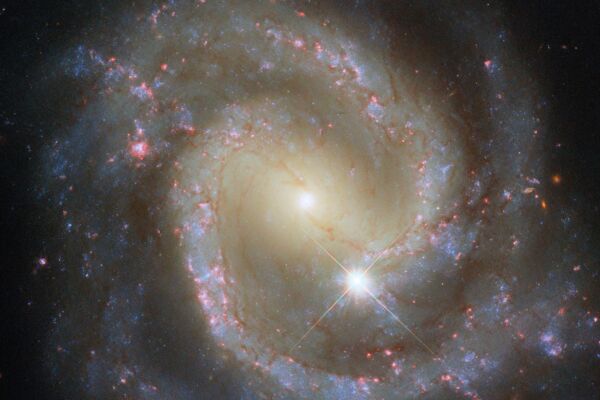NASA’s Hubble Space Telescope has captured an image of a beautiful galaxy, NGC 3507, which looks like a windmill and presents a stark contrast to its companion galaxy NGC 3501.
On May 30, NASA released the image of the spiral galaxy NGC 3507 taken by the Hubble Space Telescope. This galaxy is located in the constellation Leo, approximately 46 million light-years away from Earth.
NGC 3507 is classified as a barred spiral galaxy. Barred spiral galaxies have a short bar structure composed of stars in the middle, with the spiral arms typically extending from the end of the bar, rather than from the center of the galaxy.
Although NGC 3507 appears alone in the image, it actually has a companion galaxy, NGC 3501, which exist together as a pair. NGC 3501 is positioned outside the frame of the image and is not visible in the picture.
NGC 3507 displays a typical windmill shape, while NGC 3501 resembles a mercury streak in the sky. Despite their distinct appearances, both galaxies are spiral galaxies, and the differences observed are due to varying angles of observation.
For galaxies located only tens of millions of light-years away from Earth, such as NGC 3507 and NGC 3501, features like spiral arms, dust clouds, and bright star clusters are clearly visible. However, details of galaxies farther away are not as easily observable.
You can try to spot distant galaxies in this image. They often appear orange or yellow, possibly in circular, star-shaped, or narrow and elongated forms, with traces of spiral arms.
Astronomers use instruments called spectrographs to analyze light from these distant galaxies, studying the properties of these celestial bodies in the early universe.
Furthermore, on May 28, NASA also unveiled an image of three galaxies aligned in sequence taken by the Hubble Space Telescope.
Among these three galaxies, the farthest one is HerS 020941.1+001557, located approximately 19.5 billion light-years away from Earth, displaying a red arc partially encompassing the foreground galaxy SDSS J020941.27+001558.4, which is about 2.7 billion light-years distant.
SDSS J020941.27+001558.4 presents a bright spot at the center of the image, with its core covered by a large patch of starlight mist. The third galaxy, known as SDSS J020941.23+001600.7, appears to intersect with the curved, crescent-shaped red light generated by HerS 020941.1+001557.
The alignment of these three galaxies forms a gravitational lens phenomenon known as an Einstein ring. The gravitational lens not only bends and distorts light from distant celestial bodies but also magnifies it.
When light from a distant object curves around a massive intervening body, an Einstein ring appears. This is because the spacetime structure of the universe distorts due to mass, causing light traveling through space and time to distort as well.
Einstein rings can display full or partial light rings around foreground objects, depending on the precise alignment. This phenomenon’s impact is very subtle, not visible on a local scale, but when astronomers deal with large astronomical scales of light curvature, they can observe it clearly.
In the image, we can see light from HerS 020941.1+001557 advancing along the spacetime curve generated by SDSS J020941.27+001558.4. As this light passes through the gravitational lens, it is magnified and bent, thereby forming a unique Einstein ring around the foreground galaxy SDSS J020941.27+001558.4.

